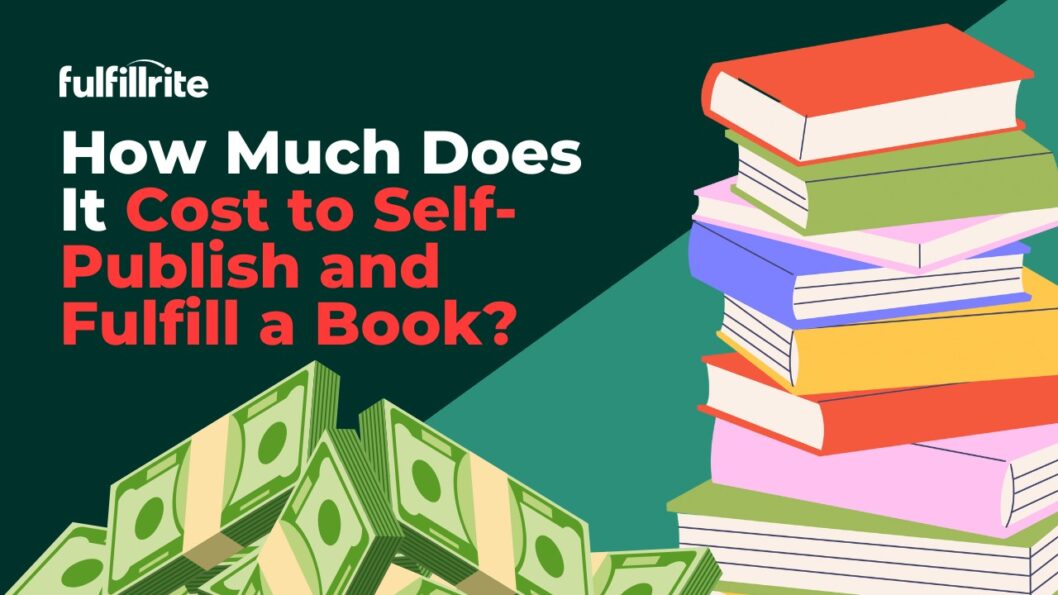Most people budget for the book, not the box.
You’ve got a book in progress. Maybe it’s almost ready to send to the printer. You’ve looked into editing. You’ve priced out cover design. You know it won’t be free, but you’ve got a plan.
The problem? Most authors don’t realize how quickly shipping and fulfillment can chew through their margins.
You can write a great book, sell it at a fair price, and still lose money. Which is a real shame, because writing takes a ton of work and it’s a noble endeavor!
This happens to authors a lot. And it’s not because their books are bad. It could just as easily happen to you if you underestimate what it costs to get that product into someone’s hands, safely and on time.
This post walks through the actual costs of self-publishing, start to finish. Not just editing and design. Not just printing. We’re talking about the whole path to the reader’s mailbox.
And yes, we’re going to talk about book fulfillment costs—because if you skip that part, the rest of your budget won’t matter much.
1. The big picture: What self-publishing really costs
You can technically publish a book on a shoestring budget. But if you want something professional, and something readers trust enough to buy, there are a few costs you can’t dodge.
Here’s what most authors should expect:
- Editing: This ranges wildly. A light proofread might cost $500. A full developmental edit could hit $2,000–$3,000. You might find someone cheaper, but you’ll feel it in the final product.
- Cover design + formatting: Expect $300 to $1,000 combined. The lower end if you’re using templates and stock images. The higher end if you’re paying for custom design and layout.
- ISBNs and barcodes: If you’re publishing under your own imprint and want to sell outside Amazon, buy your own. One ISBN costs $125. A block of 10 is $295 from Bowker.
- Printing: This is where costs swing the most. Print-on-demand (POD) might run $6–$10 per unit. Bulk printing can drop that to $2–$4 if you’re ordering 500+ copies. More on that in the next post.
Again, these are just rough estimates. We strongly encourage you to request quotes and put them all together in a spreadsheet.
But even if you go get all of the quotes for all the services we just listed, there’s a catch: none of that includes shipping.
That means many first-time authors get to the end of this list, think they’re done, and realize…oops, they’re not. Because now they’ve got 800 books in their hallway and no idea what to do with them.
That’s where fulfillment comes in.
Fulfillment means storage, packing, labeling, postage, tracking, returns—and customer service if anything goes wrong.
If you forget to include that in your plan, it will come back to bite you. But we’ll talk about how you can do that. It’s less stressful once you have the knowledge.
Printing vs. Fulfillment & Why It Matters More Than You Think
Printing is not fulfillment. And confusing the two will cost you.
Here’s how it usually goes.
You pick a printer. Maybe Amazon KDP. Maybe IngramSpark. Maybe a local shop that gives you a bulk rate. You hit “order,” boxes show up on your doorstep—or go straight to a warehouse—and you breathe a sigh of relief.
You did it. You made a book.
And then someone buys a copy.
That’s when you realize: printing the book is one job. Getting it into someone’s hands is another job entirely. That’s fulfillment. And they’re not the same thing.
Printing vs. Fulfillment: Know the difference
A lot of people assume that once the book exists, the hard part’s over. But what happens after someone clicks “Buy”? That’s the part that makes or breaks your margins.
Let’s get clear:
Printing = making the book.
Printing is the production process. You pay for paper, ink, binding, and packaging. That might be print-on-demand, where books are made one at a time. Or it might be offset or digital bulk printing, where you produce 500+ at once.
Fulfillment = delivering the book.
Fulfillment includes everything that happens after the book is printed:
- Receiving and storing inventory
- Picking and packing each order
- Applying postage
- Sending tracking info to customers
- Managing returns or replacements
- Dealing with customs, VAT, and international shipping
Printing puts the book in a box. Fulfillment gets it to the reader’s doorstep on time and in good shape.
POD is convenient, but expensive
If you use a print-on-demand platform like Amazon KDP, they’ll handle fulfillment too. But you’re paying for it.
That $8–$10 per unit fee? It covers both printing and shipping. And it adds up fast.
Worse, you have no control over how your book is packed. No say in whether it arrives bent, late, or missing a bookmark. And no way to fix it quickly if something goes wrong.
POD is great for proof copies or testing demand. It’s not ideal if you want full control or better margins.
Bulk printing lowers cost, but demands a fulfillment plan
Let’s say you print 1,000 copies through a bulk printer. Maybe you use BookBaby, PrintNinja, or a local press. Your cost drops to $2–$4 per copy.
That’s great—until you realize you now have 1,000 books to manage. You need storage. You need packing materials. You need someone to print labels and get them to the right address.
You can do that yourself, at first. A few dozen orders a week? That’s manageable.
But as you grow, it becomes a time sink—and a margin killer. Not to mention, a source of tremendous frustration if you really just want to be writing.
And indeed, in between packaging, postage, trips to the post office, and customer support, you’re spending more time running a warehouse than writing.
This is when smart authors bring in a fulfillment partner.
Fulfillrite works with bulk-printed books. We receive your inventory, store it securely, and ship it out—accurately, on time, and with real-time tracking.
You don’t touch a single padded mailer. And your reader never has to wonder if their book is lost in the mail.
Bottom line: Know what you’re paying for
Print-on-demand includes fulfillment, but you pay a premium for flexibility.
Bulk printing gives you better margins, but you need a fulfillment solution in place—or your profit gets eaten up by chaos, damage, and delays.
One is not “better” than the other. But you need to decide early which path fits your goals, and budget for both.
Real Book Fulfillment Costs & How to Keep More of Your Profit
You can write a great book and still lose money if you ship it wrong.
This is where it gets real. You’ve budgeted for editing, design, and printing. You’ve got a storefront or campaign lined up. Orders start coming in, and now the quiet expenses start piling up.
Boxes. Mailers. Labels. Postage. Storage. Returns.
Every one of those things takes a bite out of your margin.
If you don’t know what book fulfillment actually costs—or how to keep it under control—you’ll work harder and earn less. Let’s fix that.
Book fulfillment costs explained
There’s no one-size-fits-all number. But here’s what a typical self-published author can expect when working with a professional book fulfillment service.
Receiving inventory
When your printer ships books to a fulfillment center, someone has to unload and inspect them.
- Flat fee or hourly labor charge
- Expect around $25–$50 per pallet or ~$40/hour
Storage
Books are heavy. They take up space. If they sit in your garage too long, they warp. If they sit in a climate-controlled warehouse, you pay for the square footage.
- Typical cost: $10–$30/month per pallet or ~$0.40–$0.80/cubic foot
- Your actual cost depends on how much inventory you’re holding—and how fast it moves
Pick and pack
This is the labor to pull a book from the shelf, pack it securely, and print a shipping label.
- Expect ~$2–$3 per order for single-book shipments
- Add $0.50–$1 per extra item (if bundling merch or multiple books)
Packaging materials
This includes padded mailers, cardboard boxes, inserts, and protective wrap. Don’t skimp here: damaged books lead to refunds and bad reviews.
- Standard cost: ~$0.50–$1 per shipment
- Custom packaging (branded boxes, tissue, etc.) costs more
Postage
This is the big one. USPS Media Mail is cheapest, but slow. Priority Mail and international options get expensive fast.
- Domestic Media Mail: ~$3.50–$4.50 per book
- Priority: ~$8–$10
- International: $15–$25+, depending on weight and destination
- Dimensional weight fees apply if your box is too big for the contents
Fulfillrite helps optimize box size and shipping method to reduce dim weight charges, saving you from hidden costs that eat into profit.
Kitting or bundling
If you’re sending books with bookmarks, bookplates, maps, or other inserts, that adds complexity.
- Expect $0.75–$2.00 extra per order depending on item count and handling needs
- A good fulfillment partner will also catch errors (e.g. missing items) before they ship
How fulfillment impacts your profit margins
Let’s do a quick example.
You sell your book for $20.
Printing cost: $3.
Shipping + fulfillment: $8.
You net $9.
Now bump the shipping box size slightly. Now it triggers a dimensional weight fee. Shipping jumps to $12. Your net drops to $5. You just lost 45% of your profit… over an inch of cardboard.
Or say you go cheap on mailers, and 3% of your shipments arrive bent. You eat the refund cost, plus time spent fixing the issue. One star off your average review. More than just money, it damages trust.
International orders = higher risk
Without DDP (Delivered Duty Paid), your international customers might get stuck with unexpected taxes or fees. Some refuse delivery. Some leave angry reviews. Some never come back.
Returns cost time and money
They’re rare with books, but not zero. A return means:
- Restocking labor
- Lost postage
- Replacement product or refund
- Unhappy customer
Budgeting tips for first-time authors
Here’s how to stay profitable without cutting corners:
Start small
You don’t need to print 5,000 copies. A short run of 250–500 helps you test demand and control storage fees. You can always reprint.
Use preorders to fund fulfillment
Kickstarter, Gumroad, and Shopify all support preorder campaigns. This gives you upfront cash to cover printing and fulfillment before you’re out of pocket.
Plan fulfillment before launch
Too many authors try to figure out shipping after their campaign ends or site goes live. Don’t do that. Get quotes ahead of time. Price your book accordingly.
Keep your inventory moving
Slow-selling stock eats storage fees. Offer occasional promos. Bundle with merch. Run digital ad tests. Do what it takes to keep books moving off the shelf.
Final Thoughts
Self-publishing is a business. And like any business, your margins matter.
If you know what to expect—and plan for book fulfillment costs just like you do for editing or printing—you’re ahead of the game. Most authors don’t.
With the right setup, your fulfillment process fades into the background. Orders go out. Tracking numbers get emailed. Returns get handled. You don’t have to think about it. And you don’t have to spend hours at the post office.
You focus on what you actually enjoy: writing more books, building your audience, growing your career.
If you’re ready to stop packing boxes and start running your book business like a pro, Fulfillrite can help. Get in touch for a quote or to see how our services fit your next launch.

